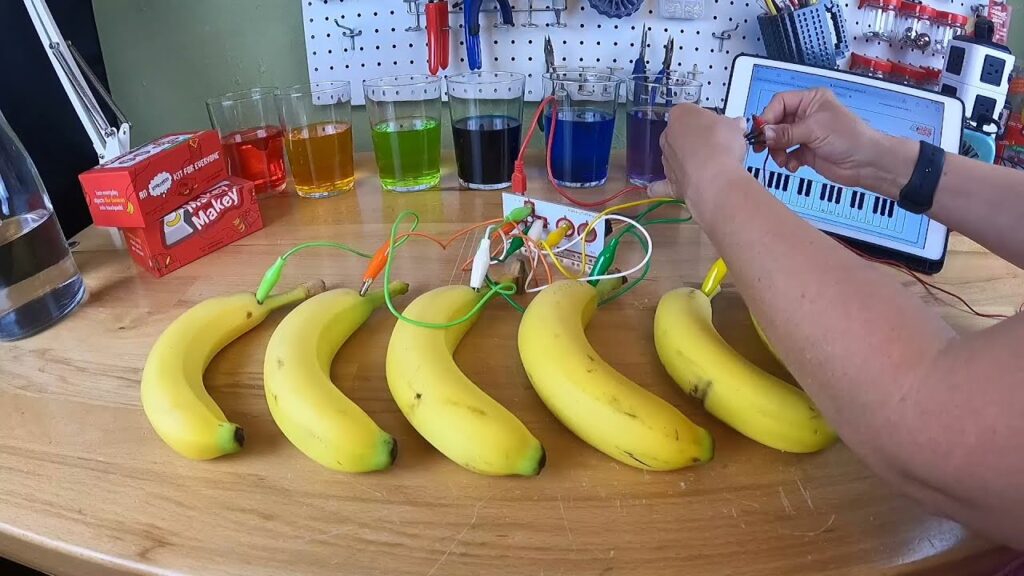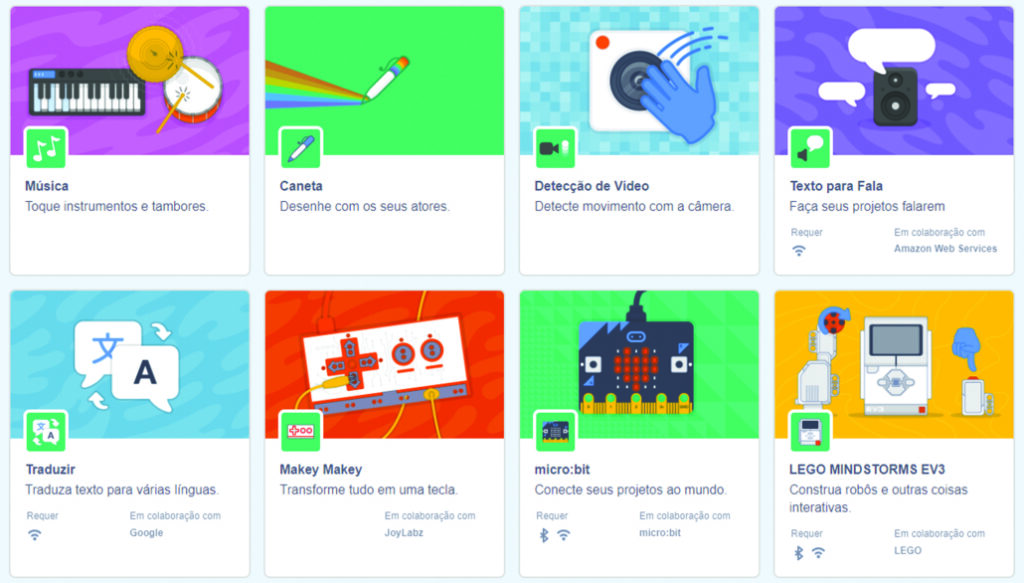CONNECT
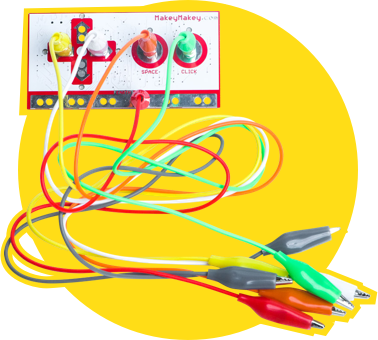
The circuit board is part of a creative interaction kit.
This board allows the transformation of common objects into “commands”, which means they become touchpads. These objects send information to the computer just like input devices such as the keyboard and mouse. With it, we can create various projects, including a banana piano or a playdough video game controller.
Touchpad: A sensitive device that executes a command when touched.
To make the circuit board work, the use of conductive materials is necessary. They are materials that conduct energy, such as metals (copper, gold, silver, and aluminum), seawater, and our bodies. But there are also materials that are not conductors of energy, such as rubber, styrofoam, glass, pure water, and oil, which cannot be used to make the circuit board work.
Watch the video and see some project examples:
Ask the students:
• What would you like to build in our classes with the circuit board?
• What did you already know about conductive materials?
CONTEMPLATE
As we’ve seen, the board makes projects more fun by turning any object that conducts electricity into a real keyboard.
Here are some of these objects:
• Fruits and vegetables: bananas, apples, lemons, or carrots can be used as keys or buttons.
• Aluminum foil sheets: small pieces of aluminum foil connected to the board’s pins can be touched or pressed to send signals.
• Pencil: used to draw circuits or connect objects directly to the board’s pins.
• Water: is conductive of electricity, so it’s possible to use containers with water as part of the circuit. For example, by dipping fingers into water-filled cups and touching conductive objects, signals are sent to the computer.
GETTING TO KNOW THE BOARD
The board has the shape of a video game controller. On the front, there are contact points for the directional arrows functions (left, right, up, and down), space bar, and mouse click.
It’s important to know that there’s a bottom bar called Earth, which acts as a wire for grounding, meaning it directs the electric current from devices to the ground.
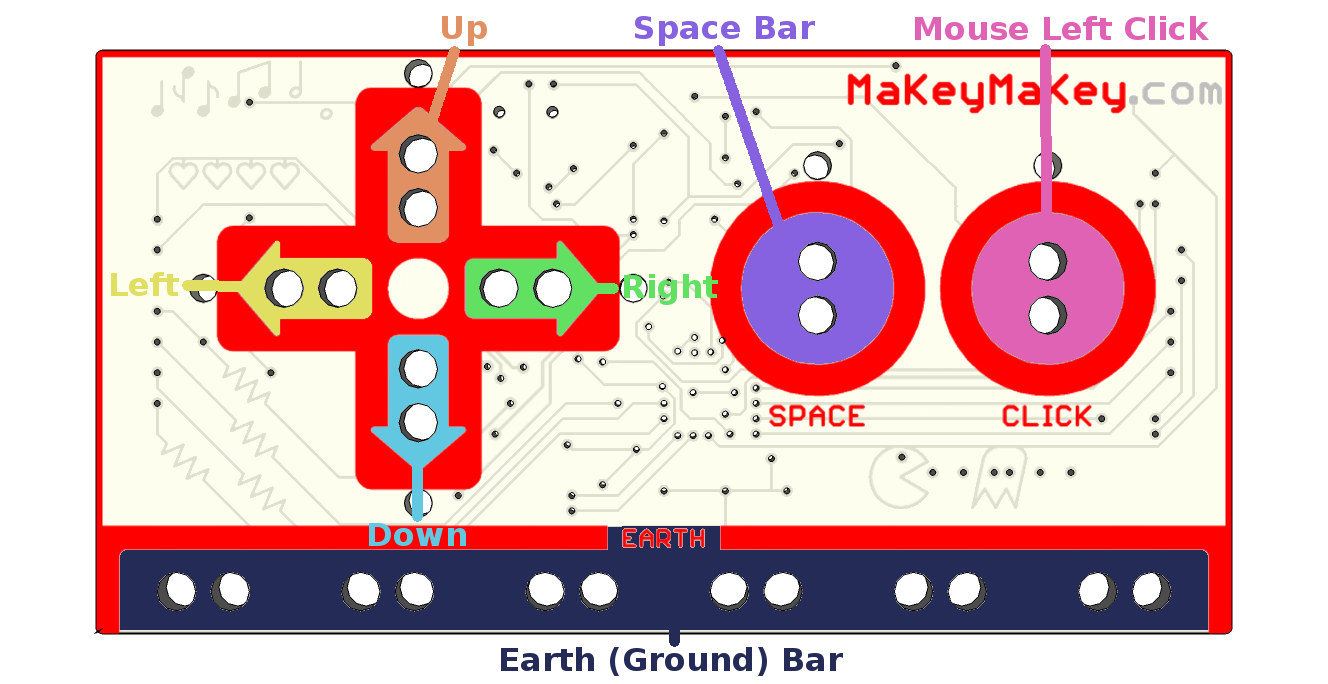
On the back of the board, there are jumpers (connectors) to be used as other keys (W, S, A, D, F, G) of a standard keyboard, as well as connections to control all mouse functions (right/left click).
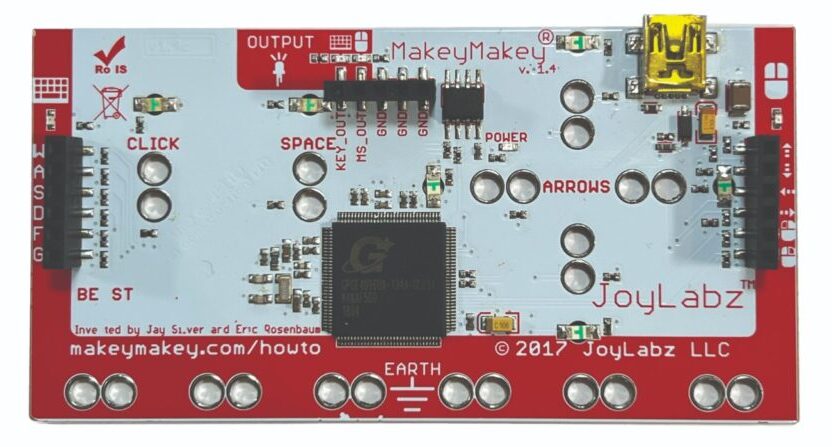
HOW TO CONNECT THE BOARD
Connect the USB cable to the computer and attach the alligator clips to the board’s contact points and to the conductive objects that will be used in the project.
The circuit with objects requires grounding. For this project, grounding will be done by the colleague interacting with the circuit. They should hold with one hand the alligator clip connected to the Earth bar while pressing the object. See what happens!
BUILD
Organize the class into teams of up to five students and distribute the circuit board kit.
ATTENTION!
• When starting and finishing the projects, make sure to clean the alligator clips, as there should be no residues. Use a brush or cotton swab for cleaning.
• Each kit should be connected to a computer. If the school does not have the necessary number of computers per team, each group can alternate the use of the computer to execute their project. At this moment, be mindful of the time of use so that everyone participates.
• When the project needs to be presented on a metal table, it is advisable to cover the table with a cloth or plastic towel, with cardboard or brown paper to not interfere with the project’s operation. If presented on the floor, a rubberized surface, such as EVA, is recommended.
• Opt for newer modeling clay, as older ones may be dried out and may not work.
• The wires cannot touch each other and must be secured with masking tape or Scotch tape.
• The contact between the alligator clip and the aluminum foil needs to be very firm. Use insulating tape to secure them.
In teams, use the components of the circuit board to build a banana piano. Bananas will become a piano because they will be connected to the circuit board using alligator clips.
Step 1: Gather the materials.
• 1 circuit board;
• 1 USB cable;
• 6 alligator clips;
• 5 bananas.

Step 2: Connect the USB cable to the board and to the computer. Attach the six alligator clips: one on the Earth bar, one on each directional arrow (left, right, up, and down), and one on the space bar. The other ends of the alligator clips will be connected to the bananas, and the one on the Earth bar will be connected to the hand of the person playing the piano.

Step 3: To program the project, we’ll use Scratch. Access the address <https://scratch.mit.edu>, click on the Add an Extension function, and then on the Makey Makey option. Now, the board will be added to the program.
Step 4: Assemble the piano programming. Click on the Choose an Actor icon to insert the Bananas actor.
Step 5: Click on the Bananas actor, go to Makey Makey, and drag the block for when the space key is pressed five times to the script area.
Step 6: To select the sound, click on the Sounds tab and on the Choose a Sound button. Choose the sounds of five piano notes: C (C Piano), D (D Piano), E (E Piano), F (F Piano), and G (G Piano).

Step 7: Go to Sound and also drag the block for play G Piano sound five times to the script area. Each play G Piano sound block should be inserted below each when the space key is pressed block.
Step 8: Change the options of the when the space key is pressed block to space, up arrow, down arrow, right arrow, and left arrow.
Step 9: Change the options of four play G Piano sound blocks to “C Piano”, “D Piano”, “E Piano”, and “F Piano”, keeping one of them as “G Piano”. Check the connections of the alligator clips and place the bananas in that order.
Step 10: The piano is ready to be played. Turn up the volume!
Watch the project model video.
CONTINUE
Share with the class the construction results:
• Did the banana piano prototype work?
• Was it difficult to use the circuit board?
Once finished, all materials should be stored.


